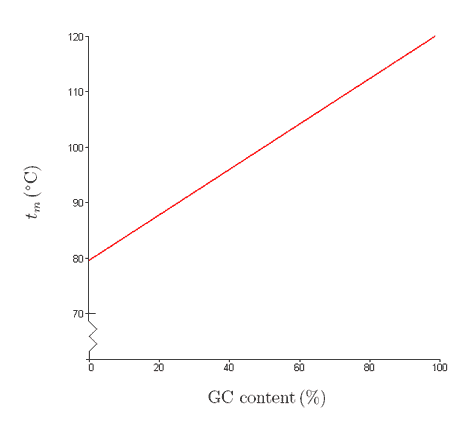Linear Functions
Introduction
|
Linear functions are commonly used in the biological sciences to describe the way one particular quantity changes at a constant rate with respect to another quantity. For example, the temperature at which the DNA double helix unwinds (also called denatures) is a linear function of the nucleotide composition of the DNA molecule. The DNA double helix is held together by hydrogen bonds between base pairs, specifically adenine bases pair with thymine bases and guanine bases pair with cytosine base. One way to disrupt these hydrogen bonds, and thus "unwind" or denature the DNA molecules is by heating the sample. Because three hydrogen bonds form between guanine/cytsine base pairs and two hydrogen bonds form between adenine/thymine base painrs, more enrgy is required to denature the former. Thus, DNA with a greater number of guanine/cytosine pairs requires more energy (and thus a higher temerpature) to denature. In fact, there is a linear relationship between the amount of guanine and cytosine in a given DNA molecule, known as the GC content, and the temperature at which the double helix will denature, called the melting point, denoted as tm. Imagine you have a number of different DNA samples, 100 base pairs in length and is dissolved in 100 mM NaCl. The samples differ only in their GC content. If you were to calculate the melting point for the different DNA molecules, and plot it against the molecule's GC content, you would get a line, as shown below
This is one biological example of the simplest type of function, the linear function. As the name implies, linear functions are graphically represented by lines. A linear function has a constant rate of change; for each unit change in the independent variable (x) there is a corresponding constant change in the dependent variable (y).
In our example of the relationship between melting temperature and GC content for DNA molecules containing 100 base pairs and dissolved in a buffer containing 100 mM NaCl, the independent variable is %GC conent and the dependent variable is the equation is tm. The equation describing tm as a linear function of %GC content is, as follows: tm= 59.9 + 0.41(%GC). In this case, the value of tm is dependant on the GC content.
In the next section we will explore the basics of linear functions.
|
The Biology Project > Biomath > Linear Functions > Introduction
Department of Biochemistry and Molecular Biophysics
The University of Arizona
January 2006
Contact the Development Team
http://www.biology.arizona.edu
All contents copyright © 2006. All rights reserved.

